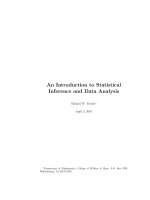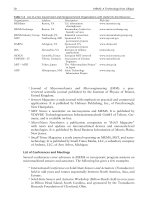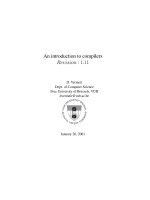- Trang chủ >>
- Khoa Học Tự Nhiên >>
- Vật lý
An introduction to quantum physics
Bạn đang xem bản rút gọn của tài liệu. Xem và tải ngay bản đầy đủ của tài liệu tại đây (6.94 MB, 567 trang )
www.pdfgrip.com
An Introduction to Quantum Physics
www.pdfgrip.com
www.pdfgrip.com
An Introduction to Quantum Physics
A First Course for Physicists, Chemists,
Materials Scientists, and Engineers
Stefanos Trachanas
www.pdfgrip.com
Authors
Stefanos Trachanas
Foundation for Research & Technology–
Hellas (FORTH)
Crete University Press
100 Nikolaou Plastira
Vassilika Vouton
70013 Heraklion
Greece
and
All books published by Wiley-VCH are
carefully produced. Nevertheless, authors,
editors, and publisher do not warrant the
information contained in these books,
including this book, to be free of errors.
Readers are advised to keep in mind that
statements, data, illustrations, procedural
details or other items may inadvertently
be inaccurate.
Library of Congress Card No.:
applied for
British Library Cataloguing-in-Publication
Data
A catalogue record for this book is
available from the British Library.
University of Crete
Department of Physics
P.O. Box 2208
71003 Heraklion
Greece
Bibliographic information published by
the Deutsche Nationalbibliothek
The Deutsche Nationalbibliothek
lists this publication in the Deutsche
Nationalbibliografie; detailed
bibliographic data are available on the
Internet at <>.
Manolis Antonoyiannakis
The American Physical Society
Editorial Office
1 Research Road
Ridge, NY 11961
United States
and
Columbia University
Department of Applied Physics & Applied
Mathematics
500 W. 120th Street
New York, NY 10027
United States
Leonidas Tsetseris
National Technical University of Athens
Department of Physics
Zografou Campus
15780 Athens
Greece
© 2018 Wiley-VCH Verlag GmbH & Co.
KGaA, Boschstr. 12, 69469 Weinheim,
Germany
All rights reserved (including those of
translation into other languages). No part
of this book may be reproduced in any
form – by photoprinting, microfilm, or
any other means – nor transmitted or
translated into a machine language
without written permission from the
publishers. Registered names, trademarks,
etc. used in this book, even when not
specifically marked as such, are not to be
considered unprotected by law.
Print ISBN: 978-3-527-41247-1
ePDF ISBN: 978-3-527-67665-1
ePub ISBN: 978-3-527-67668-2
Mobi ISBN: 978-3-527-67667-5
Cover Design Schulz Grafik-Design,
Fgưnheim, Germany
Typesetting SPi Global, Chennai, India
Printing and Binding
Printed on acid-free paper
www.pdfgrip.com
to Maria
www.pdfgrip.com
www.pdfgrip.com
vii
Contents
Foreword xix
Preface xxiii
Editors’ Note xxvii
Part I
1
1.1
1.2
1.2.1
1.2.2
1.2.3
1.3
1.3.1
1.3.2
1.3.3
1.3.4
1.3.5
1.3.6
1.3.7
1.3.8
1.3.9
1.3.10
Fundamental Principles
1
3
Introduction 3
The Principle of Wave–Particle Duality of Light 4
The Photoelectric Effect 4
The Compton Effect 7
A Note on Units 10
The Principle of Wave–Particle Duality of Matter 11
From Frequency Quantization in Classical Waves to Energy
Quantization in Matter Waves: The Most Important General
Consequence of Wave–Particle Duality of Matter 12
The Problem of Atomic Stability under Collisions 13
The Problem of Energy Scales: Why Are Atomic Energies on the Order
of eV, While Nuclear Energies Are on the Order of MeV? 15
The Stability of Atoms and Molecules Against External
Electromagnetic Radiation 17
The Problem of Length Scales: Why Are Atomic Sizes on the Order of
Angstroms, While Nuclear Sizes Are on the Order of Fermis? 19
The Stability of Atoms Against Their Own Radiation: Probabilistic
Interpretation of Matter Waves 21
How Do Atoms Radiate after All? Quantum Jumps from Higher to
Lower Energy States and Atomic Spectra 22
Quantized Energies and Atomic Spectra: The Case of Hydrogen 25
Correct and Incorrect Pictures for the Motion of Electrons in Atoms:
Revisiting the Case of Hydrogen 25
The Fine Structure Constant and Numerical Calculations in Bohr’s
Theory 29
The Principle of Wave–Particle Duality: An Overview
www.pdfgrip.com
viii
Contents
1.3.11
1.4
1.4.1
1.4.2
1.4.3
Numerical Calculations with Matter Waves: Practical Formulas and
Physical Applications 31
A Direct Confirmation of the Existence of Matter Waves: The
Davisson–Germer Experiment 33
The Double-Slit Experiment: Collapse of the Wavefunction Upon
Measurement 34
Dimensional Analysis and Quantum Physics 41
The Fundamental Theorem and a Simple Application 41
Blackbody Radiation Using Dimensional Analysis 44
The Hydrogen Atom Using Dimensional Analysis 47
2
The Schrödinger Equation and Its Statistical Interpretation 53
2.1
2.2
2.2.1
2.2.2
2.2.3
2.3
2.3.1
2.3.2
2.3.3
2.3.4
2.3.4.1
2.3.4.2
2.3.5
2.4
Introduction 53
The Schrödinger Equation 53
The Schrödinger Equation for Free Particles 54
The Schrödinger Equation in an External Potential 57
Mathematical Intermission I: Linear Operators 58
Statistical Interpretation of Quantum Mechanics 60
The “Particle–Wave” Contradiction in Classical Mechanics 60
Statistical Interpretation 61
Why Did We Choose P(x) = |𝜓(x)|2 as the Probability Density? 62
Mathematical Intermission II: Basic Statistical Concepts 63
Mean Value 63
Standard Deviation (or Uncertainty) 65
Position Measurements: Mean Value and Uncertainty 67
Further Development of the Statistical Interpretation: The Mean-Value
Formula 71
The General Formula for the Mean Value 71
The General Formula for Uncertainty 73
Time Evolution of Wavefunctions and Superposition States 77
Setting the Stage 77
Solving the Schrödinger Equation. Separation of Variables 78
The Time-Independent Schrödinger Equation as an Eigenvalue
Equation: Zero-Uncertainty States and Superposition States 81
Energy Quantization for Confined Motion: A Fundamental General
Consequence of Schrödinger’s Equation 85
The Role of Measurement in Quantum Mechanics: Collapse of the
Wavefunction Upon Measurement 86
Measurable Consequences of Time Evolution: Stationary and
Nonstationary States 91
Self-Consistency of the Statistical Interpretation and the Mathematical
Structure of Quantum Mechanics 95
Hermitian Operators 95
Conservation of Probability 98
Inner Product and Orthogonality 99
Matrix Representation of Quantum Mechanical Operators 101
Summary: Quantum Mechanics in a Nutshell 103
1.3.12
1.3.13
2.4.1
2.4.2
2.5
2.5.1
2.5.2
2.5.3
2.5.4
2.5.5
2.5.6
2.6
2.6.1
2.6.2
2.6.3
2.6.4
2.7
www.pdfgrip.com
Contents
3
The Uncertainty Principle 107
3.1
3.2
3.2.1
3.2.2
3.2.3
Introduction 107
The Position–Momentum Uncertainty Principle 108
Mathematical Explanation of the Principle 108
Physical Explanation of the Principle 109
Quantum Resistance to Confinement. A Fundamental Consequence of
the Position–Momentum Uncertainty Principle 112
The Time–Energy Uncertainty Principle 114
The Uncertainty Principle in the Classical Limit 118
General Investigation of the Uncertainty Principle 119
Compatible and Incompatible Physical Quantities and the Generalized
Uncertainty Relation 119
Angular Momentum: A Different Kind of Vector 122
3.3
3.4
3.5
3.5.1
3.5.2
Part II
Simple Quantum Systems 127
4
Square Potentials. I: Discrete Spectrum—Bound States 129
4.1
4.2
4.2.1
4.2.2
4.2.2.1
Introduction 129
Particle in a One-Dimensional Box: The Infinite Potential Well 132
Solution of the Schrödinger Equation 132
Discussion of the Results 134
Dimensional Analysis of the Formula En = (ℏ2 𝜋 2 ∕2mL2 )n2 .
Do We Need an Exact Solution to Predict the Energy Dependence on
ℏ, m, and L? 135
Dependence of the Ground-State Energy on ℏ, m, and L : The Classical
Limit 136
The Limit of Large Quantum Numbers and Quantum
Discontinuities 137
The Classical Limit of the Position Probability Density 138
Eigenfunction Features: Mirror Symmetry and the Node
Theorem 139
Numerical Calculations in Practical Units 139
The Square Potential Well 140
Solution of the Schrödinger Equation 140
Discussion of the Results 143
Penetration into Classically Forbidden Regions 143
Penetration in the Classical Limit 144
The Physics and “Numerics” of the Parameter 𝜆 145
4.2.2.2
4.2.2.3
4.2.2.4
4.2.2.5
4.2.2.6
4.3
4.3.1
4.3.2
4.3.2.1
4.3.2.2
4.3.2.3
5
Square Potentials. II: Continuous Spectrum—Scattering
States 149
5.1
5.2
5.2.1
Introduction 149
The Square Potential Step: Reflection and Transmission 150
Solution of the Schrödinger Equation and Calculation of the Reflection
Coefficient 150
Discussion of the Results 153
5.2.2
www.pdfgrip.com
ix
x
Contents
5.2.2.1
5.2.2.2
5.2.2.3
5.2.2.4
5.3
5.3.1
5.3.2
5.3.2.1
5.3.2.2
5.3.2.3
5.3.2.4
5.3.2.5
6
6.1
6.2
6.3
6.3.1
6.3.2
6.3.3
6.3.4
6.3.5
6.3.6
6.4
The Phenomenon of Classically Forbidden Reflection 153
Transmission Coefficient in the “Classical Limit” of High
Energies 154
The Reflection Coefficient Depends neither on Planck’s Constant nor
on the Mass of the Particle: Analysis of a Paradox 154
An Argument from Dimensional Analysis 155
Rectangular Potential Barrier: Tunneling Effect 156
Solution of the Schrödinger Equation 156
Discussion of the Results 158
Crossing a Classically Forbidden Region: The Tunneling Effect 158
Exponential Sensitivity of the Tunneling Effect to the Energy of the
Particle 159
A Simple Approximate Expression for the Transmission
Coefficient 160
Exponential Sensitivity of the Tunneling Effect to the Mass of the
Particle 162
A Practical Formula for T 163
167
Introduction 167
Solution of the Schrödinger Equation 169
Discussion of the Results 177
Shape of Wavefunctions. Mirror Symmetry and the Node
Theorem 178
Shape of Eigenfunctions for Large n: The Classical Limit 179
The Extreme Anticlassical Limit of the Ground State 180
Penetration into Classically Forbidden Regions: What Fraction of Its
“Lifetime” Does the Particle “Spend” in the Classically Forbidden
Region? 181
A Quantum Oscillator Never Rests: Zero-Point Energy 182
Equidistant Eigenvalues and Emission of Radiation from a Quantum
Harmonic Oscillator 184
A Plausible Question: Can We Use the Polynomial Method to Solve
Potentials Other than the Harmonic Oscillator? 187
The Harmonic Oscillator
7
The Polynomial Method: Systematic Theory and
Applications 191
7.1
7.2
7.4
Introduction: The Power-Series Method 191
Sufficient Conditions for the Existence of Polynomial Solutions:
Bidimensional Equations 194
The Polynomial Method in Action: Exact Solution of the Kratzer and
Morse Potentials 197
Mathematical Afterword 202
8
The Hydrogen Atom. I: Spherically Symmetric Solutions 207
8.1
Introduction 207
7.3
www.pdfgrip.com
Contents
8.2
8.2.1
8.3
8.3.1
8.3.2
8.3.3
8.3.4
8.3.5
8.3.6
8.3.7
8.3.8
8.3.9
8.4
Solving the Schrödinger Equation for the Spherically Symmetric
Eigenfunctions 209
A Final Comment: The System of Atomic Units 216
Discussion of the Results 217
Checking the Classical Limit ℏ → 0 or m → ∞ for the Ground State of
the Hydrogen Atom 217
Energy Quantization and Atomic Stability 217
The Size of the Atom and the Uncertainty Principle: The Mystery of
Atomic Stability from Another Perspective 218
Atomic Incompressibility and the Uncertainty Principle 221
More on the Ground State of the Atom. Mean and Most Probable
Distance of the Electron from the Nucleus 221
Revisiting the Notion of “Atomic Radius”: How Probable is It to Find
the Electron Within the “Volume” that the Atom Supposedly
Occupies? 222
An Apparent Paradox: After All, Where Is It Most Likely to Find the
Electron? Near the Nucleus or One Bohr Radius Away from It? 223
What Fraction of Its Time Does the Electron Spend in the Classically
Forbidden Region of the Atom? 223
Is the Bohr Theory for the Hydrogen Atom Really Wrong? Comparison
with Quantum Mechanics 225
What Is the Electron Doing in the Hydrogen Atom after All? A First
Discussion on the Basic Questions of Quantum Mechanics 226
9
The Hydrogen Atom. II: Solutions with Angular
Dependence 231
9.1
9.2
Introduction 231
The Schrödinger Equation in an Arbitrary Central Potential:
Separation of Variables 232
Separation of Radial from Angular Variables 232
The Radial Schrödinger Equation: Physical Interpretation of the
Centrifugal Term and Connection to the Angular Equation 235
Solution of the Angular Equation: Eigenvalues and Eigenfunctions of
Angular Momentum 237
Solving the Equation for Φ 238
Solving the Equation for Θ 239
Summary of Results for an Arbitrary Central Potential 243
The Hydrogen Atom 246
Solution of the Radial Equation for the Coulomb Potential 246
Explicit Construction of the First Few Eigenfunctions 249
n = 1 : The Ground State 250
n = 2 : The First Excited States 250
Discussion of the Results 254
The Energy-Level Diagram 254
Degeneracy of the Energy Spectrum for a Coulomb Potential:
Rotational and Accidental Degeneracy 255
Removal of Rotational and Hydrogenic Degeneracy 257
9.2.1
9.2.2
9.2.3
9.2.3.1
9.2.3.2
9.2.4
9.3
9.3.1
9.3.2
9.3.2.1
9.3.2.2
9.3.3
9.3.3.1
9.3.3.2
9.3.3.3
www.pdfgrip.com
xi
xii
Contents
9.3.3.4
9.3.3.5
9.3.3.6
9.3.3.7
9.3.3.8
The Ground State is Always Nondegenerate and Has the Full
Symmetry of the Problem 257
Spectroscopic Notation for Atomic States 258
The “Concept” of the Orbital: s and p Orbitals 258
Quantum Angular Momentum: A Rather Strange Vector 261
Allowed and Forbidden Transitions in the Hydrogen Atom:
Conservation of Angular Momentum and Selection Rules 263
10
Atoms in a Magnetic Field and the Emergence of Spin 267
10.1
10.2
10.7.1
10.7.2
Introduction 267
Atomic Electrons as Microscopic Magnets: Magnetic Moment and
Angular Momentum 270
The Zeeman Effect and the Evidence for the Existence of Spin 274
The Stern–Gerlach Experiment: Unequivocal Experimental
Confirmation of the Existence of Spin 278
Preliminary Investigation: A Plausible Theoretical Description
of Spin 278
The Experiment and Its Results 280
What is Spin? 284
Spin is No Self-Rotation 284
How is Spin Described Quantum Mechanically? 285
What Spin Really Is 291
Time Evolution of Spin in a Magnetic Field 292
Total Angular Momentum of Atoms: Addition of Angular
Momenta 295
The Eigenvalues 295
The Eigenfunctions 300
11
Identical Particles and the Pauli Principle 305
11.1
11.2
Introduction 305
The Principle of Indistinguishability of Identical Particles in Quantum
Mechanics 305
Indistinguishability of Identical Particles and the Pauli Principle 306
The Role of Spin: Complete Formulation of the Pauli Principle 307
The Pauli Exclusion Principle 310
Which Particles Are Fermions and Which Are Bosons 314
Exchange Degeneracy: The Problem and Its Solution 317
10.3
10.4
10.4.1
10.4.2
10.5
10.5.1
10.5.2
10.5.3
10.6
10.7
11.3
11.4
11.5
11.6
11.7
Part III Quantum Mechanics in Action: The Structure
of Matter 321
12
Atoms: The Periodic Table of the Elements 323
12.1
12.2
Introduction 323
Arrangement of Energy Levels in Many-Electron Atoms:
The Screening Effect 324
www.pdfgrip.com
Contents
12.3
12.4.1
12.4.2
Quantum Mechanical Explanation of the Periodic Table:
The “Small Periodic Table” 327
Populating the Energy Levels: The Shell Model 328
An Interesting “Detail”: The Pauli Principle and Atomic
Magnetism 329
Quantum Mechanical Explanation of Valence and Directionality of
Chemical Bonds 331
Quantum Mechanical Explanation of Chemical Periodicity: The Third
Row of the Periodic Table 332
Ionization Energy and Its Role in Chemical Behavior 334
Examples 338
Approximate Calculations in Atoms: Perturbation Theory and the
Variational Method 341
Perturbation Theory 342
Variational Method 346
13
Molecules. I: Elementary Theory of the Chemical Bond 351
13.1
13.2
13.2.1
13.2.2
13.3
13.3.1
13.3.2
13.3.3
13.3.4
13.3.5
13.3.6
13.3.7
13.3.8
13.4
13.4.1
13.4.2
13.4.3
Introduction 351
The Double-Well Model of Chemical Bonding 352
The Symmetric Double Well 352
The Asymmetric Double Well 356
Examples of Simple Molecules 360
The Hydrogen Molecule H2 360
The Helium “Molecule” He2 363
The Lithium Molecule Li2 364
The Oxygen Molecule O2 364
The Nitrogen Molecule N2 366
The Water Molecule H2 O 367
Hydrogen Bonds: From the Water Molecule to Biomolecules 370
The Ammonia Molecule NH3 373
Molecular Spectra 377
Rotational Spectrum 378
Vibrational Spectrum 382
The Vibrational–Rotational Spectrum 385
14
Molecules. II: The Chemistry of Carbon 393
14.1
14.2
Introduction 393
Hybridization: The First Basic Deviation from the Elementary Theory
of the Chemical Bond 393
The CH4 Molecule According to the Elementary Theory: An
Erroneous Prediction 393
Hybridized Orbitals and the CH4 Molecule 395
Total and Partial Hybridization 401
The Need for Partial Hybridization: The Molecules C2 H4 , C2 H2 , and
C2 H6 404
Application of Hybridization Theory to Conjugated
Hydrocarbons 408
12.3.1
12.3.2
12.3.3
12.3.4
12.3.5
12.3.6
12.4
14.2.1
14.2.2
14.2.3
14.2.4
14.2.5
www.pdfgrip.com
xiii
xiv
Contents
14.2.6
14.3
14.3.1
14.3.2
14.3.3
14.3.4
14.3.5
14.3.6
Energy Balance of Hybridization and Application to Inorganic
Molecules 409
Delocalization: The Second Basic Deviation from the Elementary
Theory of the Chemical Bond 414
A Closer Look at the Benzene Molecule 414
An Elementary Theory of Delocalization: The Free-Electron
Model 417
LCAO Theory for Conjugated Hydrocarbons. I: Cyclic Chains 418
LCAO Theory for Conjugated Hydrocarbons. II: Linear Chains 424
Delocalization on Carbon Chains: General Remarks 427
Delocalization in Two-dimensional Arrays of p Orbitals: Graphene and
Fullerenes 429
15
Solids: Conductors, Semiconductors, Insulators 439
15.1
15.2
15.3
Introduction 439
Periodicity and Band Structure 439
Band Structure and the “Mystery of Conductivity.” Conductors,
Semiconductors, Insulators 441
Failure of the Classical Theory 441
The Quantum Explanation 443
Crystal Momentum, Effective Mass, and Electron Mobility 447
Fermi Energy and Density of States 453
Fermi Energy in the Free-Electron Model 453
Density of States in the Free-Electron Model 457
Discussion of the Results: Sharing of Available Space by the Particles of
a Fermi Gas 460
A Classic Application: The “Anomaly” of the Electronic Specific Heat
of Metals 463
15.3.1
15.3.2
15.4
15.5
15.5.1
15.5.2
15.5.3
15.5.4
16
Matter and Light: The Interaction of Atoms with
Electromagnetic Radiation 469
16.1
16.2
Introduction 469
The Four Fundamental Processes: Resonance, Scattering, Ionization,
and Spontaneous Emission 471
Quantitative Description of the Fundamental Processes: Transition
Rate, Effective Cross Section, Mean Free Path 473
Transition Rate: The Fundamental Concept 473
Effective Cross Section and Mean Free Path 475
Scattering Cross Section: An Instructive Example 476
Matter and Light in Resonance. I: Theory 478
Calculation of the Effective Cross Section: Fermi’s Rule 478
Discussion of the Result: Order-of-Magnitude Estimates and Selection
Rules 481
Selection Rules: Allowed and Forbidden Transitions 483
Matter and Light in Resonance. II: The Laser 487
The Operation Principle: Population Inversion and the Threshold
Condition 487
16.3
16.3.1
16.3.2
16.3.3
16.4
16.4.1
16.4.2
16.4.3
16.5
16.5.1
www.pdfgrip.com
Contents
16.5.2
16.5.2.1
16.5.2.2
16.5.2.3
16.5.2.4
16.6
16.7
16.7.1
16.7.2
16.8
16.8.1
16.8.2
16.8.3
Main Properties of Laser Light 491
Phase Coherence 491
Directionality 491
Intensity 491
Monochromaticity 492
Spontaneous Emission 494
Theory of Time-dependent Perturbations: Fermi’s Rule 499
Approximate Calculation of Transition Probabilities Pn→m (t) for an
Arbitrary “Transient” Perturbation V (t) 499
The Atom Under the Influence of a Sinusoidal Perturbation:
Fermi’s Rule for Resonance Transitions 503
The Light Itself: Polarized Photons and Their Quantum Mechanical
Description 511
States of Linear and Circular Polarization for Photons 511
Linear and Circular Polarizers 512
Quantum Mechanical Description of Polarized Photons 513
Online Supplement
1
The Principle of Wave–Particle Duality: An Overview
OS1.1
OS1.1
Review Quiz
Determining Planck’s Constant from Everyday Observations
2
The Schrödinger Equation and Its Statistical Interpretation
OS2.1
OS2.2
OS2.3
Review Quiz
Further Study of Hermitian Operators: The Concept of the
Adjoint Operator
Local Conservation of Probability: The Probability Current
3
The Uncertainty Principle
OS3.1
OS3.2
OS3.3
OS3.4
Review Quiz
Commutator Algebra: Calculational Techniques
The Generalized Uncertainty Principle
Ehrenfest’s Theorem: Time Evolution of Mean Values and the
Classical Limit
4
Square Potentials. I: Discrete Spectrum—Bound States
OS4.1
OS4.2
OS4.3
Review Quiz
Square Well: A More Elegant Graphical Solution for Its Eigenvalues
Deep and Shallow Wells: Approximate Analytic Expressions for Their
Eigenvalues
5
Square Potentials. II: Continuous Spectrum—Scattering
States
OS5.1
OS5.2
Review Quiz
Quantum Mechanical Theory of Alpha Decay
www.pdfgrip.com
xv
xvi
Contents
6
The Harmonic Oscillator
OS6.1
OS6.2
Review Quiz
Algebraic Solution of the Harmonic Oscillator: Creation and
Annihilation Operators
7
The Polynomial Method: Systematic Theory and Applications
OS7.1
OS7.2
OS7.3
Review Quiz
An Elementary Method for Discovering Exactly Solvable Potentials
Classic Examples of Exactly Solvable Potentials: A Comprehensive
List
8
The Hydrogen Atom. I: Spherically Symmetric Solutions
OS8.1
Review Quiz
9
The Hydrogen Atom. II: Solutions with Angular Dependence
OS9.1
OS9.2
Review Quiz
Conservation of Angular Momentum in Central Potentials, and Its
Consequences
Solving the Associated Legendre Equation on Our Own
OS9.3
10
Atoms in a Magnetic Field and the Emergence of Spin
OS10.1 Review Quiz
OS10.2 Algebraic Theory of Angular Momentum and Spin
11
Identical Particles and the Pauli Principle
OS11.1 Review Quiz
OS11.2 Dirac’s Formalism: A Brief Introduction
12
Atoms: The Periodic Table of the Elements
OS12.1 Review Quiz
OS12.2 Systematic Perturbation Theory: Application to the Stark Effect and
Atomic Polarizability
13
Molecules. I: Elementary Theory of the Chemical Bond
OS13.1 Review Quiz
14
Molecules. II: The Chemistry of Carbon
OS14.1 Review Quiz
OS14.2 The LCAO Method and Matrix Mechanics
OS14.3 Extension of the LCAO Method for Nonzero Overlap
15
Solids: Conductors, Semiconductors, Insulators
OS15.1 Review Quiz
OS15.2 Floquet’s Theorem: Mathematical Study of the Band Structure for an
Arbitrary Periodic Potential V(x)
OS15.3 Compressibility of Condensed Matter: The Bulk Modulus
OS15.4 The Pauli Principle and Gravitational Collapse: The Chandrasekhar
Limit
www.pdfgrip.com
Contents
16
Matter and Light: The Interaction of Atoms with
Electromagnetic Radiation
OS16.1 Review Quiz
OS16.2 Resonance Transitions Beyond Fermi’s Rule: Rabi Oscillations
OS16.3 Resonance Transitions at Radio Frequencies: Nuclear Magnetic
Resonance (NMR)
Appendix 519
Bibliography 523
Index 527
www.pdfgrip.com
xvii
www.pdfgrip.com
xix
Foreword
As fate would have it, or perhaps due to some form of quantum interference,
I encountered Stefanos Trachanas’ book on Quantum Physics in its prenatal
form. In the late 1970s, while a graduate student at Harvard, Trachanas was
working on a set of notes on quantum physics, written in his native language.
He occasionally lent his handwritten notes (the file-sharing mode of that era) to
friends who appreciated his fascination with Nature’s wonders. At the time, I was
an undergraduate student at the technical school down the river, struggling to
learn quantum physics, and was very grateful to have access to Trachanas’ notes.
I still remember the delight and amazement I felt when reading his notes, for
their clarity and freshness, and for the wonderful insights, not to be found in any
of the classic physics texts available at the time (our common native language
also helped). It is a great pleasure to see that in the latest version of his book on
Quantum Physics, this freshness is intact, enriched from decades of teaching
experience. This latest version is of course a long way from his original set of
notes; it is a thorough account of the theory of quantum mechanics, expertly
translated by Manolis Antonoyiannakis and Leonidas Tsetseris, in the form of a
comprehensive and mature textbook.
It is an unusual book. All the formulas and numbers and tables that you find
in any other textbook on the subject are there. This level of systematic detail is
important; one does expect a textbook to contain a complete treatment of the
subject and to serve as a reference for key results and expressions. But there are
also many wonderful insights that I have not found elsewhere, and numerous
elaborate discussions and explanations of the meaning of the formulas, a crucial
ingredient for developing an understanding of quantum physics.
The detailed examples, constantly contrasting the quantum and the classical
pictures for model systems, are the hallmark of the book. Another key characteristic is the use of dimensional analysis, through which many of the secrets of
quantum behavior can be elucidated. Finally, the application of key concepts to
realistic problems, including atoms, molecules, and solids, makes the treatment
of the subject not only pedagogically insightful but also of great practical value.
The book is nicely laid out in three parts: In Part I, the student is introduced to “the language of quantum mechanics” (the author’s astute definition
of the subject, as mentioned in the Preface), including all the “cool” (my
quotes) concepts of the quantum realm, such as wave–particle duality and the
uncertainty principle. Then, in Part II, the language is used to describe the
www.pdfgrip.com
xx
Foreword
standard simple problems, the square well, the harmonic oscillator, and the
Coulomb potential. It is also applied to the hydrogen atom, illustrating how
this language can capture the behavior of Nature at the level of fundamental
particles—electrons and protons. Finally, in Part III, the student is given a
thorough training in the use of the quantum language to address problems
relevant to real applications in modern life, which is dominated by quantum
devices, for better or for worse. Many everyday activities, from using a cell
phone to call friends to employing photovoltaics for powering your house, are
directly related to quintessentially quantum phenomena, that is, the physics
of semiconductors, conductors, and insulators, and their interaction with
light. All these phenomena are explained thoroughly and clearly in Trachanas’
book. The reader of the book will certainly develop a deep appreciation of the
principles on which many everyday devices are based. There is also a lovely
discussion of the properties of molecules and the nature of the chemical bond.
The treatment ranges from the closed sixfold hydrocarbon ring (“benzene”) to
the truncated icosahedron formed by 60 carbon atoms (“fullerene”), with several
other important structures in between. This discussion touches upon the origin
of chemical complexity, including many aspects related to carbon, the “element
of life” (again my quotes), and occupies, deservedly, a whole chapter.
For the demanding reader, there are several chapters of higher mathematical
and physical sophistication. The two cases that stand out are Chapter 7 on
the polynomial method and Chapters 10 and 11 on the nature of spin and on
identical particles. The treatment of the polynomial method is quite unusual
for an introductory text on quantum physics, but it is beautifully explained in
simple steps. Although the author suggests that this chapter can be skipped at
first reading, in my view, it is not to be missed. Anyone who wondered why all
books deal with just three standard problems (square well, harmonic oscillator,
Coulomb potential), will find here some very enticing answers, and a wonderful
discussion of which types of problem yield closed analytical solutions. For the
practitioners of numerical simulations, this approach provides elegant insights
to the well-known Kratzer and Morse potentials. It is satisfying to see that these
familiar tools for simulating the properties of complex systems have simple
analytical solutions. Finally, Trachanas argues that the nature of the electron’s
“spin” is related to the essence of quantum measurement, and this is nicely
connected to the character of elementary particles, “fermions” or “bosons,”
and to their interaction with magnetic fields. The concepts are deep, yet their
explanation is elegant and convincing. It is presented through a playful set of
questions and answers, with no recourse to technical jargon. The effect of this
approach is powerful and empowering: The reader is left with the impression
that even the most puzzling concepts of quantum physics can actually be grasped
in simple, intuitive terms.
www.pdfgrip.com
Foreword
A famous joke among physicists is that “One does not really understand
quantum mechanics, but simply gets used to it.” To an undergraduate student
being exposed to quantum physics for the first time, this phrase may come very
close to how it feels to speak Nature’s language of the atomic scale. Trachanas’
Quantum Physics aims to remove this feeling and in my opinion it succeeds
brilliantly.
Cambridge, Massachusetts
March, 2017
Efthimios Kaxiras
Harvard University
www.pdfgrip.com
xxi
www.pdfgrip.com
xxiii
Preface
Learning quantum mechanics is like learning a foreign language. To speak it well
one needs to relocate to the country where it is spoken, and settle there for a
while—to make it one’s day-to-day language. This book has been designed so that
the teaching of quantum mechanics as a “foreign language” satisfies this residence
requirement. Once the readers become familiar with the fundamental principles
(Part I) and study some simple quantum systems (Part II), they are invited to “settle” in the atomic world (Part III) and learn quantum mechanics in action. To talk
the language of quantum mechanics in its natural habitat. So, in a way, this is a
double book: Quantum Mechanics and Structure of Matter. It includes a complete introduction to the basic structures of nonnuclear matter—not simply as
“applications” but as a necessary final step toward understanding the theory itself.
This is an introductory book, aimed at undergraduate students with no prior
exposure to quantum theory, except perhaps from a general physics course.
From a mathematical perspective, all that is required from the readers is to have
taken a Calculus I course and to be simply familiar with matrix diagonalization
in linear algebra.
Those readers with some previous exposure to quantum mechanical
concepts—say, the wave–particle duality principle—can readily proceed to
Chapter 2. But a quick browse through Chapter 1 may prove useful for them also,
since this is a quite conceptual chapter that prepares the ground for acceptance
of the rather bizarre quantum mechanical concepts, which are so alien to our
everyday experience.
An integral part of the book is the online supplement. It contains review
quizzes, theory supplements that cover the few additional topics taught in a
more formal course on quantum mechanics, and also some further applications.
Installed in an open-source platform—Open edX—designed for massive open
online courses (MOOCs), the online supplement offers an interactive online
learning environment that may become an integral part of academic textbooks
in the future. It can be freely accessed at .
Had it not been for the generous decision of colleagues Manolis Antonoyiannakis and Leonidas Tsetseris to undertake the translation and editing of the
original Greek edition, this book would not have seen the light of day. My
deepest thanks therefore go to them. They tirelessly plowed through the original
text and my own continuous—and extensive—revisions, as well as two entirely
www.pdfgrip.com









